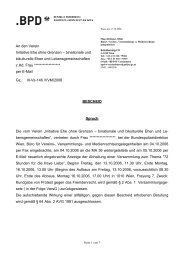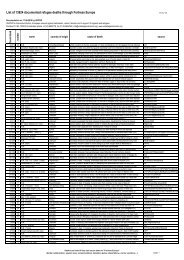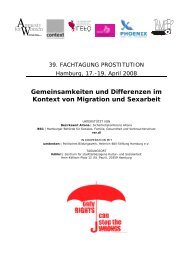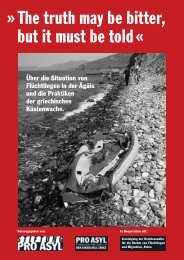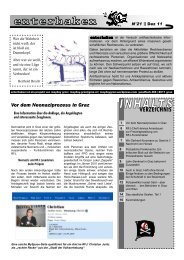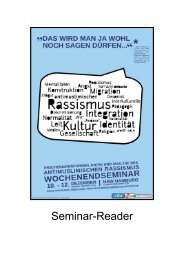Turin's CIE - International University College of Turin
Turin's CIE - International University College of Turin
Turin's CIE - International University College of Turin
Create successful ePaper yourself
Turn your PDF publications into a flip-book with our unique Google optimized e-Paper software.
P A R T B . C O N D I T I O N S O F D E T E N T I O N<br />
This section assesses the conditions <strong>of</strong> detention inside <strong>Turin</strong>’s <strong>CIE</strong> by examining: family<br />
relationships, children and <strong>CIE</strong>; <strong>CIE</strong> and prison; practical day-to-day issues in <strong>CIE</strong>; health and<br />
medical issues; relationships with <strong>CIE</strong> staff; and relationships between detainees. Each <strong>of</strong> these<br />
issues are diverse and yet to an extent interrelated, since they all impact detainees’ everyday lives<br />
in detention, their vulnerability and their relative experiences <strong>of</strong> the conditions within which they<br />
live. Throughout Part B we will paint a picture <strong>of</strong> what it can mean to be detained inside <strong>Turin</strong>’s<br />
<strong>CIE</strong>: a centre that geographically a bus ride away from the parks, piazzas and c<strong>of</strong>fee shops <strong>of</strong><br />
<strong>Turin</strong>, and yet still seems a world away.<br />
I. THE DECISION TO DETAIN<br />
Prior to considering the conditions <strong>of</strong> detention it is first crucial to remember that in order for a<br />
person to be inside <strong>Turin</strong>’s <strong>CIE</strong>, an initial administrative decision must be made by the Italian<br />
authorities to detain that particular migrant. Whilst legal and administrative procedures<br />
pertaining to <strong>CIE</strong> detention will be discussed in detail in Part C, to an extent the conditions <strong>of</strong><br />
detention and the decision to detain are interrelated due to the arbitrariness test under Article 5<br />
<strong>of</strong> the European Convention for the Protection <strong>of</strong> Human Rights and Fundamental Freedoms<br />
(ECHR) 11 concerning the right to liberty and security <strong>of</strong> person. The right to liberty and security<br />
<strong>of</strong> person is also well founded in international law, as per Article 9 <strong>of</strong> the <strong>International</strong> Covenant<br />
on Civil and Political Rights (ICCPR) 12 , and Article 3 and Article 9 <strong>of</strong> the Universal Declaration <strong>of</strong><br />
Human Rights (UDHR) 13 .<br />
In particular, Article 5 ECHR limits the circumstances in which the deprivation <strong>of</strong> liberty is<br />
justifiable, noting that deprivation <strong>of</strong> liberty must not be arbitrary. The European Court <strong>of</strong><br />
Human Rights (ECtHR) expressly forbade any detention which violated the prohibitions on<br />
arbitrariness, was unnecessary and disproportionate. In light <strong>of</strong> the proportionality test, factors<br />
discussed throughout Part B, such as family life, health issues and the nature <strong>of</strong> detention, will<br />
be relevant to determining if an individual’s detention meets the following Article 5 ECHR nonarbitrariness<br />
test 14 , which provides that immigration detention must:<br />
i. Be carried out in good faith and not involve deception on the part <strong>of</strong> the authorities;<br />
ii.<br />
iii.<br />
Be closely connected to the purpose <strong>of</strong> preventing unauthorised entry <strong>of</strong> the person<br />
to the country or deportation;<br />
The place and conditions <strong>of</strong> detention must be appropriate, bearing in mind that the<br />
measure is applicable not to those who have committed criminal <strong>of</strong>fences but to<br />
people who have fled from their own country, <strong>of</strong>ten in fear for their lives;<br />
11 European Convention for the Protection <strong>of</strong> Human Rights and Fundamental Freedoms, opened for signature<br />
4 November 1950, ETS 5 (entered into force 3 September 1953 and ratified by Italy 26 October 1955).<br />
12 <strong>International</strong> Covenant on Civil and Political Rights, opened for signature 16 December 1966, 999 U.N.T.S.<br />
171 (entered into force 23 March 1976).<br />
13 Universal Declaration <strong>of</strong> Human Rights, G.A. Res. 217A (III), U.N. Doc. A/810 at 71 (1948).<br />
14 Saadi v. United Kingdom, 13229/03, Council <strong>of</strong> Europe: European Court <strong>of</strong> Human Rights, 29 January 2008,<br />
para.74.<br />
16 | P a g e




